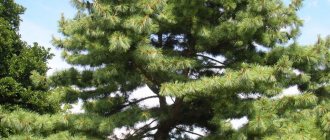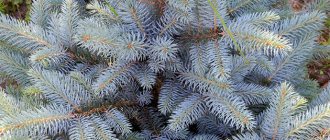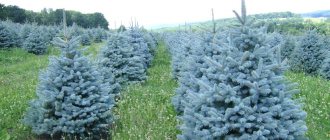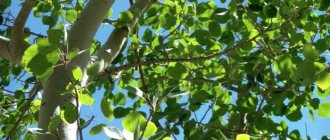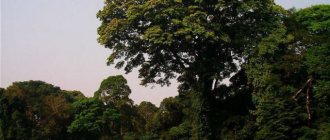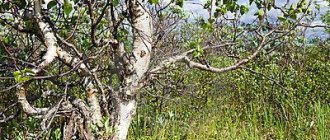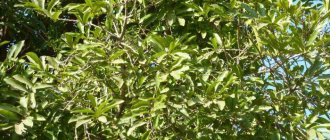General information
Pine (Pinus) . A genus of coniferous evergreen trees, less commonly creeping shrubs of the pine family. The needles are narrow, soft or needle-shaped, in bunches (2, 3, 5 needles each) located at the ends of shortened shoots. Mature cones are usually 3-10 cm long. The seeds are nut-shaped, mostly with a wing. The root system is powerful and deep. Pines are light-loving. They often form pure stands on sandy soils (pine forests). The tree grows on dry quartz sands devoid of fertile soil, and on peaty soils, and even on sphagnum bogs. Adaptability to various types of soil is determined by the high plasticity of the root system, intensive growth of roots, the ability to cover a more or less significant part of the soil layer, penetrate deep layers of soil, and overcome horizons with unfavorable properties.
With a low concentration of nutrients in the soil, pine is able to accumulate more organic matter than spruce and birch. A small content of mobile forms of mineral substances in the soil leads to a sharp drop in pine growth. The presence of carbonates in the soil improves forest growing conditions. On saline soils and solonetzes, pine grows much better than other conifers.
Pines, as a rule, live up to 150-500 years, but among them there are also long-livers (for example, North American pine is long-lived and lives up to 5000 years, being the longest-living tree species in the world).
Scots pine has always been and remains the most faithful and caring companion for humans. We are amazed by the tree's rapid growth, its frost resistance, its height up to 50 m, and its well-cleaned trunk.
Thanks to the unique golden-brown color of the trunk and evergreen needles, pine is widely used in the creation of parks and forest parks.
The genus includes more than 100 species. Pine is widespread in Europe and Asia - from the Pyrenees in the west to the Sea of Okhotsk in the east and from the Kola Peninsula in the north to the shores of the Mediterranean and Black Seas in the south. In Russia, 8 species are distinguished, of which the largest areas are occupied by the two-coniferous Scots pine (Pinus silvestris) - the range is from the Kola Peninsula and the White Sea to the shores of the Pacific Ocean, and the five-coniferous (pine) Siberian pine, which produces edible seeds called pine nuts. The range of the latter covers the areas of the north-east of the European part of Russia, the Urals and Siberia. The group of cedar pines also includes Korean or Manchurian pine, which grows in our country in the Khabarovsk and Primorsky territories, and dwarf cedar (creeping shrub 40-50 cm high, with a trunk length of 1.5-2.5 m), forming dense thickets in Siberia (from Transbaikalia), on the coast of the Sea of Okhotsk, Kamchatka, Sakhalin and the Kuril Islands.
Pine is a valuable forest-forming species. In Russia, forests whose plantings are dominated by two-coniferous pines (for example, Scots, chalk, hooked) are usually called pine, or pine forests, and those with a predominance of five-coniferous cedar pines are called cedar, or cedar forests, or cedar forests.
Among the sprawling green ocean of Scots pine, interesting species and form deviations also appear, which Russian and foreign foresters encounter from time to time.
To content >>>
Use in landscape design
If the selected pine variety is suitable for growing in a specific area, it can become simply an indispensable component of landscaping both large and limited in space. In the latter case, it is better to choose dwarf or even shrub forms of pine, which will ideally fit into the overall picture when organizing rock gardens, rockeries, artificial streams or even flower beds.
Large specimens can be used to create a hedge along a fence or as a single addition to the overall decoration of the site. Depending on the chosen variety, with the help of trees or shrub forms, you can advantageously emphasize the beauty of other vegetation on the site, but the crop is best combined with thuja, berry and golden yew, konica spruce, and different varietal variations of mountain pine.
We advise you to find out how to use pine in landscape design of your site.
When creating flower arrangements, the plant will certainly become an excellent background for variegated and bright flowers, the main thing is that the needs of the crops used to decorate the site coincide as much as possible. Under no circumstances should you plant pine next to birches, bird cherry trees, or roses. With such a neighborhood, only one type of plant will survive, which is often caused by soil acidification or excessive absorption of nutrients by one of the neighbors.
Pine subspecies
Within its modern habitat, Scots pine is characterized by great variability in its main characteristics. There are 5 subspecies, or geographical races, of Scots pine.
Scots pine grows in the European part of our country. By the age of ripeness, it reaches a height of 40 m and a diameter at chest height of 1-1.5 m. In youth, the crown is cone-shaped, and at a more mature age it acquires a spherical shape. There are wide- and narrow-crowned forms. The shoots are light brown or yellow, the branches and trunk are covered with a brownish-red peeling crust. The needles are 4-6 cm long and remain on the tree for 2-3 years, sometimes 4-5 years.
The appearance of Scots pine, growing in different habitat conditions, served as the basis for identifying two soil ecotypes of the subspecies under consideration: chalk pine and swamp pine. Cretaceous pine grows on chalk outcrops in the south of European Russia. The crown is wide, often starting at the soil surface. Old specimens have an umbrella-shaped crown. The needles are shortened, wide and thicker. The length of the cones is 2.5-3 cm, their color is gray.
Swamp pine has a number of differences from pines growing on drained soils. These differences are manifested mainly in appearance, the anatomical differences are much smaller. They are characterized by a small height (no more than 10-15M), short needles, small cones.
Hooked pine . Grows in Crimea and the Caucasus. Reaches a height of 20-25 m in height and 1 m in diameter. Irregular thickenings are observed in the lower part of the trunk. The crown varies greatly from narrow to wide, and has a pyramidal, oval or umbrella shape. The needles are straight or slightly bent, hard, sharp, gray-green, up to 7 cm long. The cones are yellow; the scutes are convex, immediately rise steeply from the upper edge and bend downwards in the form of a blunt hook; the seeds are brown. Hook pine has two climatic ecotypes, confined to different altitudinal zones.
Lapland pine . More common in Siberia. The trees reach a height of 20 m and a diameter of 22 cm. The crown is narrow, the branches in the lower part remain for many years. The needles are gray-green, short (3.5mm), thick and wide, stay on the tree for up to 8 years. The cones are short - 3-4 cm, straw-yellow or brownish-yellow in color.
Siberian pine . Grows in Asia. This subspecies differs little in terms of growth energy and taxation indicators from the subspecies of Scots pine, forest, but at the same time has a number of characteristic features that differ from it.
The crust on the bottom of the trunk is thick, dark brown in color, covers the trunk to 2/3 of its height, then light yellow. There are both narrow- and wide-crowned forms. The needles live for more than 5 years, their length is 4-6 cm, rarely reaching 10 cm. The cones are 5 cm long. Steppe pine. It grows in Siberia in isolated forests, as well as on the southern steppe slopes of Transbaikalia, reaching a height of 20-25 m and over 1 m in diameter. The crust is up to 2/3 of the trunk in height, thick, dark gray in color, above that it is light brown. On older trees, the dark-colored bark usually falls off and the entire trunk is light brown. The needles are long, sometimes up to 11 cm, and fall off after 6-7 years. The cones are large, often reaching 7 cm. Based on the color of the cones, two forms are distinguished: light gray and dark brown.
To content >>>
Content
- 1 Etymology
- 2 Description 2.1 Bark
- 2.2 Foliage
- 2.3 Cones
- 5.1 Ecology
- 6.1 Lumber and construction
- 7.1 Literature
- 10.1 Quotes
Pine subspecies have several forms or ecotypes
Collar pine. Studying the diversity of forms of Scots pine, Professor B.V. Grozdov discovered the original ringed form of pine in the Bryansk region and called it collared. The tree grew in an old pine plantation, its trunk was with rough cracks and had, on the illuminated side, in places overgrown with whorled branches, what looked like visors made of exfoliated bark plates; the canopies rose along the trunk to a height of up to 6 meters.
Walter Seitz reported about the same pine in one of the German forestries in 1927; he classified it as a scaly form. The pine was 200 years old, with twelve canopies made of narrow scales of bark and also in place of overgrown whorls from the illuminated part of the trunk. In 1955, similar pines were found in the forests of Poland.
Observations have shown that changes in the bark at the site of overgrown whorls are characteristic of older trees. The bark first completely covers the unevenness of the whorls, and then cracks, and its layers, rising, take on an inclined shape, which is facilitated by the abundance of sunlight and dry air. Collar pine is found in such places. On the shady side of the trunk, all the pines we encountered did not have canopies; The bark of such pines peeled off in “tablets.”
The trees are most often found in pine-oak plantations, oak-beech with hornbeam, and beech with an admixture of Scots pine and hornbeam. There are pines aged 115-125 years.
Seven years of observations over an area of about 10 hectares were unexpected. It turns out that the number of trunks with collars and the number of collars on each counted trunk changed annually: in the first year there were 56 pines with collars, after 3 years - 92, after another 2 years - 120, and in the last year - 156. It is also interesting that in the first year of observation, trees with four collars predominated (maximum - ten), and in the last year - with seven (maximum - 16-19 collars). This means that new collars must appear on ripe and overmature pines. Another original feature has been noticed in collared pines (especially in the Lviv region): you can find trees not only with half rings, but also with full rings, and the number of the latter increases with the increase in the total number of collars on the trunks.
Collar pines have deeply cracked bark and only a few thin trunks. The well-developed crown and slenderness of the trees attract attention: the thinness of the trunks and the cleanliness of the trunks from branches. Pines bear fruit abundantly and produce seeds of great germination. All this speaks of the high forestry properties of this rare, remarkable tree and the need for a more in-depth study of it and its use in forest park construction.
Chalk pine . There are rocky chalk slopes on the Central Russian Upland and the Donetsk Ridge. They would seem to be completely unsuitable for tree life. And yet, the plants managed to settle here and even survive to this day. These are chalk pines.
A tall tree, up to 30 m in height, has a wide crown, quite often descending down the trunk; with age it turns into an umbrella-shaped one. The vitality of chalk pine is facilitated by the root system: the anchor roots pass through heavy soil without branches, and at the ends they form a mass of thin, hair-thin roots, entwining chalk blocks like felt. It is interesting that at a depth of up to 1.5 meters these blocks are wet from the surface; on the felt itself, tiny droplets of water are visible.
The needles of chalk pine are somewhat shorter, wider and thicker than those of Scots pine. The cones are up to 3 cm long; scientists explain their reduced size by poor soils.
Cretaceous pine is not distinguished as a special species, since there are no differences in the anatomical structure of wood and needles; scientists see in it only a variety of Scots pine. According to most, chalk pine is a relic. Its peculiarity of growing essentially on bare chalk has historically developed a long time ago and is hereditary. For normal growth and development of trees, a high concentration of alkaline substances is required. The characteristics of chalk pine have, of course, not only scientific, but also practical value, since it is possible to use these trees wherever there are chalk slopes.
Studies of plantings in the Belgorod region on bare chalk showed that only chalk pine and Crimean pine can grow there, while other species die or acquire dwarf forms.
Foresters overcome some difficulties when creating stands of chalk pine: it is difficult, for example, to collect seeds on steep slopes, and at the same time, small islands of surviving natural plantings cannot yet meet the needs for seed material. Now measures have been taken to strengthen the protection of pockets of rare pine - the most valuable reserve of the seed fund - and to create a reserve regime in the places where it grows.
Grave pine , or funerary pine . She often landed in cemeteries in Korea. In our Far East, it is currently distributed in small areas or groups, significantly distant from each other, in the southwestern part of the Primorsky Territory, as well as in the Girin and Mukden provinces of Northeast China. In the past, even houses were built from its wood.
The tree differs sharply from other related species in its appearance and ability to grow in dry places and in full sun. Wide umbrella-shaped dark green crowns and yellowish-orange trunks of pine trees stand out against the background of deciduous trees. Pine settles on granite outcrops and rocks, on steep southern slopes and ridge ridges exposed to winds, on humus-depleted soils containing large amounts of crushed stone, as well as on sandy coastal deposits.
According to scientists, gravel pine is a fast-growing valuable species of great interest for forestry, for strengthening soils, protecting them and protecting water.
In one of the Far Eastern pine groves, 100 years old, under extremely unfavorable conditions (excessive dryness, rocky soil, frequent fires), the pine reached a height of 12 m and had a diameter at chest height of more than 40 cm. In somewhat more favorable conditions, trees are found much larger and reach the age of ripeness by 90 years.
Academician V.L. Komarov said about the characteristics of the grave pine and its plantings: “This is a completely unique type of vegetation, clearly different from all the others... not a forest tree, but one grown in the light.”
Based on a combination of characteristics (limited range, stable ecological features, and others), the grave pine is an older species compared to the Scots pine. The latter, as a younger, progressive species, quickly spread and became one of the pine forest-forming species throughout much of Eurasia. Grave pine has reduced its range to a minimum due to changes in climatic conditions (primarily due to humidity), and later - under the influence of human activity. Therefore, pine forests in the Primorsky Territory are recognized as relict.
Pyramid pine . Several years ago, interesting information appeared: in Northern Kazakhstan, scientists discovered a peculiar pine tree. It had a narrow-conical pyramidal crown, and thin branches along its entire length extended from the trunk at a strictly acute angle. The pine naturally differed in appearance from its relatives growing nearby - from the Scots pine. The tree had quite good growth: at the age of 60 it gained a height of 22.5 m and a diameter of 30 cm at chest height.
Further research and observations showed that the pyramidal trait was preserved in the offspring: seedlings (two-year-olds) grown from pine seeds and planted in the ground also had a pyramidal crown by the age of 5-6 years. Observations are still ongoing.
To content >>>
Application
Due to the high quality of pine wood and the rich vitamin and mineral composition of other parts, such trees are often used in a variety of sectors of human activity. Thus, with proper processing, shoots, buds and needles can become excellent raw materials for the preparation of medicines , extracts from the plant serve well in the chemical industry, and the tree itself is a valuable species in construction, for which there are several explanations.
Video: Scots pine
In medicine
For medical use, at the end of winter or at the beginning of spring, pine buds are harvested by cutting them with sharp pruners along with the rest of the stem (to form a small crown). After drying in a well-ventilated place, they will become an excellent component of useful decoctions, infusions and bath liquids, especially as an antitussive, diuretic or disinfectant.
Pine needles contain about 1% essential oil, up to 0.2% ascorbic acid , resin and useful tannins. Having collected it in the form of “paws” at cutting sites, pine oil can be prepared from young shoots and cones, which will later be included in antispasmodic and anti-inflammatory drugs.
Check out traditional recipes for treating pine buds.
In addition, pine oil is a valuable product for lung problems, so it is added to solutions for inhalation or dripped into hot baths. Aromatherapy based on pine extracts can be used only if a person is not allergic to coniferous plants, otherwise, even as an air freshener, the plant can cause an allergic attack.
In the chemical industry
The main thing that Scots pine can provide to the chemical industry is oleoresin (resin), which is formed in the resin ducts of the plant’s wood. After collection, the specified substance is melted and filtered, trying to get rid of water and foreign impurities, to obtain a product called “turpentine”. During the distillation of oleoresin with water steam, about 25% of the essential oil - oleoresin turpentine - is distilled from it, after additional purification of which the finished turpentine oil remains.
The turpentine and rosin resin obtained as a result of distillation of the product are used in the production of paints and varnishes, flavors, adhesives, solvents and other similar products. Rosin is subsequently used in the manufacture of soap, paper and rubber, and in some cases, oil for rubbing bows and strings of musical instruments.
Find out how you can use pine resin.
The amount of finished resin and turpentine directly depends on the climatic conditions of the pine trees, their age and the nature of the soil. Dry distillation of wood and stumps leads to the production of first improved quality turpentine, and then technical tar and wood vinegar, after which coal remains in the distillation kettle.
In construction
For construction purposes, the wood of old trees, usually over 100 years old, is mainly used. This option is one of the densest and contains a large amount of resins, thanks to which it is practically resistant to rotting. The hardness and ease of processing of pine raw materials largely depend on soil moisture and average temperature conditions, therefore, when felling trees, preference is given to trees growing on dry soils.
You might be interested in learning how to make pine cone mulch.
The high environmental friendliness of pine is rated at 5 points, and the plant does not lose its healing properties even after construction processing: supporting floors and wall finishing material made from this wood help eliminate pathogens and prevent the development of infectious diseases in households.
There are several main features of pine trees that builders must take into account:
- Presence of knots on the surface . It has been proven that plants growing in the harsh northern climate are characterized by fewer knots, an almost straight trunk and a minimum distance between annual rings. The last indicator affects the strength, softness and friability of lumber: the smaller it is, the better.
- The presence of resinous deposits between the fibers . They protect the wood from rotting, so they must be present here in sufficient quantities.
- Differences in the diameter of the tree between its lower and upper parts , which directly affects the convenience of wood processing and allows you to harvest lumber of different shapes.
The advantage of pine wood is the ability to process the material using any available tools, and after drying and other pre-treatment, all parts made from it can be easily varnished and painted, which is highly valued when creating furniture, flooring, creating frames and shutters . Gluing such material is not a problem.
Pests and diseases
Harmful insects, fungal and other diseases, and some species of wild animals play a negative role in the life of pine forests. Young pine trees are inhabited by many insects that damage various parts of plants. On light sandy, loamy soils, insects cause great harm, the larvae of which damage the roots of pine trees. The May oriental beetle is especially harmful. The flight of these beetles begins at the end of April-May and lasts about a month. Females lay eggs in the soil to a depth of 10-40 cm. The larvae that emerge from the eggs first feed on thin roots. As they grow, they develop thicker roots. The larvae grow for 3-4 years. In the summer, the larvae are found in the upper horizons of the soil, and closer to autumn they go deeper to 70-120 cm, where they overwinter.
Young pine trees are often damaged by shoots - summer, winter, bud and tar.
Leaf roller butterflies are commonly called shoot moths, the caterpillars of which damage the buds and shoots of pine trees, resulting in multi-topped trunks, which impairs the growth, quality and productivity of plantings.
The large pine weevil causes significant damage to pine trees. It appears especially often in clear-cuts in lingonberry and blueberry forests.
Young pines growing on dry soils often suffer from pine subbark mites. Numerous needle-eating insects that feed on needles in the larval (caterpillar) phase are also dangerous. As a result of the loss of needles, tree stands completely or partially dry out, at the same time being an object for the reproduction of stem pests in them. The pine silkworm is considered the most dangerous pest of pure pine forests.
No less serious pine-eating pests of pine plantings: pine cutworm, sawflies, Siberian silkworm, nun silkworm, pine moth, star weaver. Protection of pine forests from damage by pine-eating pests is ensured by a set of preventive and exterminatory control measures.
Pine trunks and branches are damaged by a large number of insects, so-called stem pests. These include bark beetles, longhorned beetles, borers, etc. Stem pests, as a rule, settle on trees that are physiologically weakened by unfavorable factors: drought, livestock grazing, damage by pine-eating insects. Reproducing on weakened trees, these pests also spread to viable trees. Most also settle on freshly cut trees and harvested wood.
Wood worn down by stem pests loses its technical properties.
Forest protection measures to combat stem pests are aimed mainly at eliminating the causes that weaken the vital activity of plantations.
Pine forests often suffer from diseases caused by fungi, bacteria, and viruses. In forest nurseries, one- and two-year-old seedlings and young trees are damaged by a fungus, the common schutte. The first external signs of the disease appear on the needles in the form of straw-yellow spots; later the needles become redder and fall off, which leads to the death of the plant. To protect against Schutte diseases, preventive measures should be taken, including agrotechnical and chemical control measures.
Other types of fungi that can cause damage to pine: resin cancer, pine sponge, root sponge. Pine roots are often affected by honey fungus.
From the animal world, moose cause great harm. They not only bite shoots and gnaw the bark, but also break and trample young trees, and are also an indirect cause of the spread of stem pests and fungal diseases.
Pine forests suffer from snow and snow blows.
To content >>>
Distribution in nature
Common pine is often called European pine, but it is distributed over a fairly wide area, from Portugal, Turkey, Mongolia, the Caucasus to Eastern Siberia or even the Arctic Circle. The tree is also naturalized in Canada, whose climatic conditions suit it best.
Find out how many years the Scots pine lives.
In its natural growing environment, the crop forms pure pine forests, although it can be combined with oak, aspen, spruce and birch. Depending on the subspecies and form, the plant is located at an altitude of 0 to 2600 m above sea level and in any case is provided with everything necessary for active growth and development.
Recommendations
Quotes
- Western Sunset Garden Book
. 1995. pp. 606–607. ISBN 978-0-376-03851-7. - "List of plants Version 1.1." Retrieved December 15, 2015.
- "Where are you from? - Reference Credo. credoreference.com
. - Fattig, P. (2011, January 23). "The highest of the high." Mail Tribune
. Medford, Oregon. Archived from the original on September 23, 2012. Retrieved April 20, 2022. - Fattig, P. (2011, January 23). "The highest of the high." Mail Tribune
. Medford, Oregon. Archived from the original on 2012-09-23. Retrieved 2011-01-27. - Ryan M., Richardson D.M. (December 1999). "Full Pine." Bioscience
.
49
(12): 1023–1024. Doi:10.2307/1313736. JSTOR 1313736. - "Continued: More stories about the Prometheus tree and how it died." Los Angeles Times
. 2015-02-28. Received 2020-10-16. - ^ a b
Eveleth, Rose.
"How One Man Accidentally Killed the Oldest Tree in History." Smithsonian Magazine
. Received 2020-10-16. - Zeng, Lanling; Wang, Guozhao (2009). "Modeling the golden ratio of plants." Progress of Natural Science
.
19
(2): 255–260. doi:10.1016/j.pnsc.2008.07.004. The ratio between two pine needles is 0.618, […] the angle between two neighbors is about 135°, and the angle between the main stem and each branch is close to 34.4°, which is the golden ratio of 90°. - Bracewell, Ronald; Rawlings, John. "Pinus (Pine) notes." Stanford Trees
. Retrieved February 2, 2022. - IN AND. Receptionist. (2018). Mystical melodies
. Dorrance Publishing. - Tomback D.F. (June 1982). "Seed dispersal of whitebark pine by Clark's nutcracker: a mutualism hypothesis." Journal of Animal Ecology
.
51
(2):451–467. Doi:10.2307/3976. JSTOR 3976. - Ran JH, Shen TT, Wu X, Gong X, Wang XQ (December 2022). "Phylogeny and evolutionary history of Pinaceae updated by transcriptomic analysis." Molecular phylogenetics and evolution
.
129
: 106–116. Doi:10.1016/j.ympev.2018.08.011. PMID 30153503. - Patricia E. Ryberg; Gar W. Rothwell; Ruth A. Stockey; Jason Hilton; Jean Mapes; James B. Riding (2012). "Revisiting the relationships between stem and crown groups of pinaceae: the oldest record of the genus Pinus
from the Early Cretaceous of Yorkshire, United Kingdom."
International Journal of Plant Sciences
.
173
(8):917–932. Doi:10.1086/667228. - Hernandez-Leon S., Gernandt D. S., Perez de la Rosa J. A., Hardon-Barbolla L. (2013-07-30). "Phylogenetic relationships and species delimitation in pine sections trifoliae inferred from plastid DNA." PLOS ONE
.
8
(7):e70501. Bibcode:2013PLoSO...870501H. Doi:10.1371/journal.pone.0070501. PMC 3728320. PMID 23936218. - ^ a b
Burton Vern Barnes;
Warren Herbert Wagner (January 2004). Trees of Michigan: A Guide to the Trees of the Great Lakes Region
. University of Michigan Press. P. 81–. ISBN 978-0-472-08921-5. In the archive from the original dated 05/11/2016. - Flores-Renteria L., Vegier A., Ortega del Vecche D., Ortiz-Medrano A., Pinero D., Whipple A. V., et al. (December 2013). "Genetic, morphological, geographic, and ecological approaches reveal phylogenetic relationships in complex groups, exemplified by the recently diverged species of pinyon pine (Subsection Cembroides)." Molecular phylogenetics and evolution
.
69
(3):940–9. Doi:10.1016/j.ympev.2013.06.010. PMID 23831459. - "Pines". Fundamentals of Biology
. Received 2019-10-31. - "Pinus ssp. (Tree), Overall Impact.” Global Invasive Species Database
. Invasive Species Specialist Group. March 13, 2006. Archived from the original July 26, 2011. Retrieved March 2, 2011. - ^ a b c
Filipyak M (01/01/2016).
"Pollen stoichiometry can influence detrital terrestrial and aquatic food webs." Frontiers in Ecology and Evolution
.
4
: 138. doi:10.3389/fevo.2016.00138. - “Choice of wood type – HQ with timber frame.” Wood frame HQ
. Retrieved 2018-01-04. - Trees for Pulp (PDF). Paper.org
. - "Wood Processing". weathertight.org.nz. 2010-10-18. Retrieved May 18, 2022.
- “5 Ways to Decorate with Pine Branches.” Home Decorating Trends - Homedit
. 2012-12-04. Retrieved 2018-01-04. - McAfee MJ (1911). Book-basket made of pine needles
. Library of Congress. New York: Pine-Needle Pub. Co. - Solanki S (12/17/2018). "5 Radical Material Innovations That Will Shape the Future." CNN Style
. Retrieved 2018-12-17. - "Pine Plantation Rotation" (PDF). Forests of New South Wales. In the archive (PDF) from the original on 03/08/2016. Retrieved April 1, 2016.
- Frank A. Roth II, Extension Forester. “Thinning to Improve Pine Timber” (PDF). Department of Agriculture, University of Arkensas. Archived from the original (PDF) on October 9, 2016. Retrieved April 3, 2016.
- "NZ Farm Forestry - Radiata Pine Silviculture in Chile." www.nzffa.org.nz
. Retrieved 2020-08-03. - "New Zealand Farm Forestry - NZFFA Guide No. 1: Introduction to Radiata Pine Growing." www.nzffa.org.nz
. Retrieved 2020-08-03. - Manley, Bruce (07/01/2020). "Impact on profitability, risk, optimal crop rotation age and afforestation from changing New Zealand's emissions trading scheme to an averaging approach." Forest Policy and Economics
.
116
: 102205. doi:10.1016/j.forpol.2020.102205. ISSN 1389-9341. - "Genus Pinus (pine)". Coniferous Society
. Retrieved October 29, 2022. - Zeng WQ, Jia LR, Zhang Y, Tseng JQ, Chen X, Gao X, Feng S, Huang YN. (March 2011). "Antiboring and antimicrobial action of a water-soluble extract of Cedrus deodara needles." Journal of Food Science
.
76
(2):C318–23. Doi:10.1111/j.1750-3841.2010.02023.x. PMID 21535752. - Park IS, Jeong MH, Hwang HJ, Park MR, Lee SH, Kim SG, Kim M (August 2011). "Antioxidant activity and analysis of proanthocyanidins from pine needles (Pinus densiflora)". Nutrition Research and Practice
.
5
(4): 281–7. Doi:10.4162/nrp.2011.5.4.281. PMC 3180677. PMID 21994521. - Ulukanli Z., Karaberklu S., Bozok F., Ateş B., Erdogan S., Tsenet M., Karaaslan M.G. (December 2014). "Chemical composition, antimicrobial, insecticidal, phytotoxic and antioxidant effects of essential oils of Mediterranean Pinus brutia and Pinus pinea." Chinese Journal of Natural Medicines
.
12
(12): 901–10. Doi:10.1016/s 1875-5364 (14) 60133-3. PMID 25556061. - Muir J. Yosemite
. - In short DS. Secret
. - Pole, Evgeniy. Poems of childhood / Norwegian lullaby
. - Bai Juyi "Pine Trees in the Courtyard"
- Winthrop T. Life under the Open Air
. - Book of Scottish Song
. - Pissarro C (1903). . Retrieved April 1, 2022.
- Britton N. L., Brown A. (1913). . Illustrated Flora of the Northern States and Canada
.
1
. USDA-NRCS Plant Database. Retrieved 2018-01-04. - “NEHEMIAH 8:15 KJV And they shall proclaim and proclaim in all their cities, and in Jerusalem, saying, Go ye to...”.” www.kingjamesbibleonline.org
. Retrieved 2018-01-04. - Eberhard, Wolfram (2003 [1986 (German version 1983)]), A Dictionary of Chinese Characters: Hidden Symbols in Chinese Life and Thought
.
London, New York: Routledge. ISBN 0-415-00228-1, sub
“Pine”.
Bibliography
- Farjeon A (2005). Pines
(2nd ed.). Leiden: E. J. Brill. ISBN 90-04-13916-8. - Little Jr. E.L., Critchfield W.B. (1969). Divisions of the genus Pinus (Pine trees). Miscellaneous.
Publ. 1144 (Chief Documentation Number: A 1.38: 1144) (Report). US Department of Agriculture. - Richardson D.M., ed. (1998). Ecology and biogeography of pine
. Cambridge, England: Cambridge University Press. item 530. ISBN 0-521-55176-5. - Sulavik S.B. (2007). Adirondack;
Of Indians and Mountains, 1535-1838. . Fleischmann, New York: Purple Mountain Press. pp. 244 pp. ISBN 978-1-930098-79-4. - Mirov N.T. (1967). Genus Pinus
. New York, NY: Ronald Press. - "Classification of Pines". Lovett Pinetum Charitable Foundation.
- Mirov N.T., Stanley R.G. (1959). "Pine". Annual Review of Plant Physiology
.
10
: 223–238. Doi:10.1146/annurev.pp.10.060159.001255. - Phillips, R. (1979). Trees of North America and Europe
. New York, NY: Random House, Inc. ISBN 0-394-50259-0. - Earle, Christopher J., ed. (2018). " Pinus
".
Gymnosperm Database
.
Etymology
The modern English name "pine" comes from the Latin. pine
, which some have traced to the Indo-European base
*yama-
“Resin” (source in English
pituitary gland
).[3]
Until the 19th century, pine trees were often called firs (from Old Norse fura
, through Middle English
strong
).
In some European languages, Germanic cognates of the Old Norse name are still used to refer to pine - in Danish Fyr
, Norwegian
fura/fure/furu
, Swedish
fura/furu
, Dutch
Vuren
, and German
Föhre
... But in modern English,
spruce
is now limited to spruce (
Abies
) and Douglas Fir (
Pseudotsuga
).
Distribution
Monterey Pine in Sydney, Australia, which were introduced to the region in the late 19th century.
Pines are native to the Northern Hemisphere, and in some parts of the tropics to the Southern Hemisphere. Most regions of the Northern Hemisphere (see List of pine trees by region) host some native species of pine trees. One species (Sumatran pine) crosses the Sumatra equator to 2°S latitude. In North America, various species are found in regions at latitudes ranging from 66°N to 12°S.[ citation needed
]
Pines can be found in a variety of environments, from semi-arid deserts to tropical forests, from sea level to 5,200 meters (17,100 ft), and from the coldest to the hottest environments on Earth. They are often found in mountainous areas with favorable soils and at least some water.[18]
Various species have been introduced into the temperate and subtropical regions of both hemispheres, where they are cultivated as timber or grown as ornamental plants in parks and gardens. Some of these introduced species have become naturalized, and some are considered invasive in some areas[19] and threaten natural ecosystems.
Ecology
Pine forest in Vagamon, southern Western Ghats, Kerala (India)
Pines grow well on acidic soils, some also on calcareous soils; most require good soil drainage, preferring sandy soils, but a few (such as False Pine) tolerate poorly drained, moist soils. Some are able to sprout after forest fires (for example, Canary pine). Some species of pines (such as bishop pine) require fire to recover and their populations slowly decline with fire suppression regimes.
Some species are adapted to extreme conditions caused by altitude and latitude (for example, dwarf Siberian pine, mountain pine, white pine, and bristlecone pines). Pinyon pine and a number of others, especially Turkish pine and gray pine, are especially well adapted to growing in hot, dry semi-desert climates.[ citation needed
]
The seeds are commonly eaten by birds such as grouse, blackbills, jays, nuthatches, siskins and woodpeckers, as well as squirrels. Some birds, especially the spotted nutcracker, Clark's nutcracker, and pinyon jay, are important in dispersing pine seeds to new areas. Some sometimes eat pine needles. Lepidoptera (butterfly and moth) species (see list of Lepidoptera that feed on pine trees), Symphytanus species of pine sawfly, and goats.[ citation needed
]
Pine pollen may play an important role in the functioning of detrital food webs.[20] Nutrients from pollen help detritivores develop, grow, and mature, and may also allow fungi to decompose nutritionally deficient debris.[20] Pine pollen is also involved in the movement of plant matter between terrestrial and aquatic ecosystems.[20]
Gallery
- Ancient Pinus longaeva
, California, UNITED STATES
- A Khasi pine tree in Benguet, Philippines
- Huangshan pine (Pinus hwangshanensis
), Anhui, China
- Baskets made of pine needles.
- A growing female Scots pine cone on a mountain in Perry County, Pennsylvania.
- A prescribed fire in European black pine (Black pine
) woodland, Portugal
- Pinus sylvestris
prepared for transportation, Hungary
- Tongue and groove solid pine flooring
- Pinus Taeda
bark
- Woodcut inscription of Chosui Yabu's "Three Auspicious Friends" (Three Friends of Winter) at the Brooklyn Museum. The artist was active c. 1830-1864, and the woodcut dates from about 1860.
- Adult and freshly fallen female cones (Pinus strobus.
)
- Crooked Forest in Nowe Czarnowo, Poland
- Blooming young pine cones
- Painting depicting the turpentine industry.
- Roots of an old pine tree in Ystad 2022.
- Forchem tall oil refinery in Rauma, Finland.
Evolutionary history
Conifers arose about 300 million years ago, and pines perhaps 200 million years ago.
Pinus
the largest genus of Pinaceae, the pine family, which is the oldest and largest family of conifers.
It dates back to 206 million years ago.[13] Based on recent transcriptome analyses, Pinus
is most closely related to the genus
Cathay
, which, in turn, is closely related to spruce.
These genera, with spruce and larch, form the pinoid clade of pinaceae. The oldest confirmed fossil of this genus is Pinus yorkshirensis
from the Hauterivian-Barremian boundary (131–129 Ma) at Speeton Clay, England.[14]
Evolutionary history of the genus Pinus
hybridization was complicated. Pines are prone to interspecific reproduction. Wind pollination, long lifespan, generational overlap, large population size, and weak reproductive isolation increase the likelihood of interbreeding between species.[15] As pines have diversified, the transfer of genes between different species has created a complex history of genetic relatedness.
